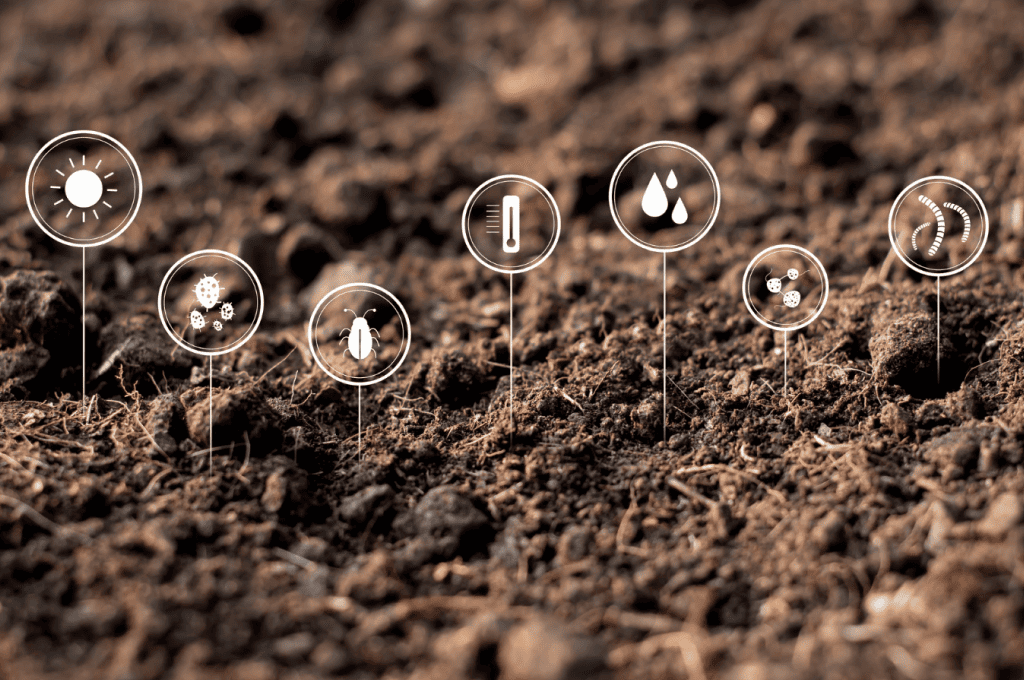
Product walkthrough, trial, POCs, enterprise offering, support and more. Speak with one of our specialists.


Product walkthrough, trial, POCs, enterprise offering, support and more. Speak with one of our specialists.

Climate changes

In discussions about climate change, we often hear about solutions such as renewable energy, energy efficiency, or electric vehicles. However, there is one solution that is rarely highlighted yet has great potential in absorbing carbon dioxide (CO2) from the atmosphere: soil organic carbon (SOC).
SOC is part of the soil organic matter (SOM) derived from decomposed plant residues, roots, and soil organisms. This carbon is stored in the soil and can persist from a few years to thousands of years, depending on environmental conditions and land management practices. Soils rich in organic matter are generally more fertile, store more water, and support high crop productivity.
Carbon stored in soil not only benefits soil fertility but also helps reduce greenhouse gas concentrations in the atmosphere. Through a process known as carbon sequestration, plants absorb CO2 from the atmosphere via photosynthesis. When plants die and decompose, their carbon can enter the soil as organic matter, creating relatively stable carbon reserves. If this process continues sustainably, soil can become one of the largest natural carbon sinks helping to slow climate change.
On the other hand, unsustainable land management can reverse this process. Activities such as deforestation, land burning, overgrazing, and the use of heavy machinery that damages soil structure can release stored organic carbon back into the atmosphere as CO2. This transforms soil from a carbon sink into a source of emissions. Therefore, maintaining and increasing SOC is crucial in the global strategy to slow global warming.
In recent decades, scientists and policymakers have begun to recognize the great potential of SOC. One global initiative highlighting this issue is the "4 per 1000" program launched at the Paris Climate Conference in 2015. This program encourages countries to increase soil carbon stocks by 0.4% each year. This figure may sound small, but research shows such an increase could be enough to balance all of humanity's annual carbon emissions globally.[Ref]
So, how can we increase carbon in the soil? One emerging approach is regenerative agriculture. This practice combines techniques such as:
All these practices aim to reduce soil disturbance and increase biomass returned to the soil. For example, by not plowing the soil, its structure remains intact, and microorganisms can thrive. Cover crops also play an important role as they keep soil covered year-round, reducing erosion and increasing organic matter as they decompose.
Farmers and indigenous communities have long practiced such methods, often without scientific labels or technical terms. Recognition of this local knowledge is important because the success of increasing SOC greatly depends on the local context: soil type, climate, farming culture, and government policies.
However, increasing SOC is not easily achieved in a short time. There are many challenges to face. First, the process of carbon sequestration by soil is slow. Significant changes can take years, even decades, depending on soil conditions and intervention intensity[Ref]. Second, not all types of soil have the same capacity to store carbon. Some tropical soils already very low in organic matter may take longer to recover and become effective carbon sinks[Ref].
Moreover, economic incentives are needed for farmers to adopt regenerative practices that may not bring immediate financial benefits. Changing farming methods also requires training, technology, and access to supportive markets. Without support from governments and financial institutions, it will be difficult for farmers to abandon long-standing practices.
Amid these challenges, promising innovations are emerging. One is market-based approaches such as carbon farming. In this scheme, farmers who successfully increase SOC can sell carbon credits to companies or governments seeking to offset their emissions. However, this mechanism is still in its early stages and not widely available, especially in developing countries. Additionally, there is still debate about how to accurately measure and verify SOC increases to ensure the system is fair and transparent[Ref].
Even so, the potential benefits of increasing SOC are not limited to climate issues. Soils rich in carbon are usually:
This shows that increasing SOC can also help food security, reduce the risk of floods and droughts, and support soil biodiversity. Thus, improving soil carbon content is a sustainable investment with benefits from many perspectives.
As the general public, we can also contribute. One way is to support products from sustainable or regenerative agriculture. As consumers, we can start being more critical in choosing food, considering its carbon footprint, and supporting environmentally friendly practices. On the other hand, governments can create policies that encourage SOC enhancement, such as subsidies for organic fertilizers, farmer training, or incentives for land conservation.
Indonesia itself has great potential to utilize this opportunity. With vast agricultural and forest lands, we can make soil our ally in tackling climate change. However, this can only be achieved if there is synergy between farmers, researchers, civil society, and policymakers. A comprehensive and long-term-oriented approach is the key.
Awareness of the importance of soil organic carbon may still be low, but its role is enormous. At a time when the world is searching for quick and efficient climate solutions, the answer may be right under our feet. Soil is not just a source of life, but it can also be the planet's savior from the climate crisis if we manage it wisely.






















Jejakin’s green programs combine high-tech monitoring, biodiversity restoration, and community-led initiatives to deliver powerful, sustainable change across ecosystems.








